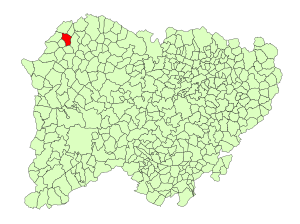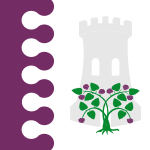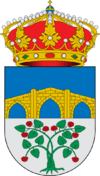La Zarza de Pumareda facts for kids
Quick facts for kids
La Zarza de Pumareda
|
|||
|---|---|---|---|
|
|||

Location in Salamanca
|
|||
| Country | Spain | ||
| Autonomous community | Castile and León | ||
| Province | Salamanca | ||
| Comarca | Vitigudino | ||
| Subcomarca | La Ramajería | ||
| Area | |||
| • Total | 28 km2 (11 sq mi) | ||
| Elevation | 701 m (2,300 ft) | ||
| Population
(2018)
|
|||
| • Total | 148 | ||
| • Density | 5.29/km2 (13.69/sq mi) | ||
| Time zone | UTC+1 (CET) | ||
| • Summer (DST) | UTC+2 (CEST) | ||
| Postal code |
37253
|
||
La Zarza de Pumareda is a small village and municipality located in the western part of Spain. It is found in the province of Salamanca, which is part of the larger region called Castile and León. This charming village is known for its quiet rural life and beautiful natural surroundings.
Contents
Where is La Zarza de Pumareda?
La Zarza de Pumareda is in the Province of Salamanca, a region in western Spain. It is part of a sub-region known as La Ramajería. The village sits at an elevation of about 701 meters (2,300 feet) above sea level. This means it's located in a slightly elevated area, offering nice views of the countryside.
Geography and Landscape
The area around La Zarza de Pumareda is mostly rural. You'll find rolling hills, fields, and some rocky areas. The landscape is typical of the Meseta Central, a large plateau in central Spain. Rivers and streams flow through the region, helping the local plant life grow.
Nearby Natural Features
The village is close to the Arribes del Duero Natural Park. This park is famous for its deep river canyons formed by the Duero River. It's a great place for nature lovers to explore. The park is home to many types of birds and other wildlife.
A Look at History
The history of La Zarza de Pumareda is tied to the wider history of the Salamanca province. Like many villages in this area, its roots go back many centuries. Over time, people settled here to farm the land and raise animals.
What Does the Name Mean?
The name "La Zarza de Pumareda" has an interesting meaning. "La Zarza" refers to a type of thorny bush, like a blackberry bush. "Pumareda" comes from the word for apple trees. So, the name might suggest a place where thorny bushes and apple trees once grew in abundance. This gives us a clue about the natural environment of the area long ago.
Life in the Village
La Zarza de Pumareda is a small community. In 2018, its population was about 148 people. Life here is peaceful and connected to nature. Many residents work in farming or related activities.
Local Economy
The main activities in La Zarza de Pumareda are traditional ones. These include:
- Agriculture: Growing crops like cereals and olives.
- Livestock: Raising animals such as sheep and cattle.
- Small businesses: Local shops and services that support the community.
Community and Daily Life
Even though it's a small village, La Zarza de Pumareda has a strong sense of community. People often know their neighbors well and help each other out. Children attend local schools, and families participate in village events.
Culture and Traditions
Like many Spanish villages, La Zarza de Pumareda celebrates its traditions. These often include local festivals and religious holidays. These events are a chance for the community to come together.
Village Festivals
Villages in Spain often have patron saint festivals. These are lively events with music, dancing, and traditional food. They are a big part of the local culture and a fun time for everyone.
Traditional Cuisine
The food in La Zarza de Pumareda reflects the local agriculture. You might find dishes made with fresh vegetables, meats, and local cheeses. Simple, hearty meals are common, often prepared using traditional recipes passed down through generations.
Nature and Wildlife
The natural surroundings of La Zarza de Pumareda are rich in biodiversity. The area's climate and landscape support various plants and animals.
Local Flora
The plant life includes Mediterranean shrubs, oak trees, and various wildflowers. In spring, the fields can be covered with colorful blooms. The "zarza" (thorny bush) mentioned in the village's name is still common.
Local Fauna
The region is home to many types of wildlife. You might see:
- Birds: Eagles, vultures, and storks are common, especially near the Arribes del Duero Natural Park.
- Mammals: Wild boar, deer, and rabbits live in the surrounding countryside.
- Reptiles and amphibians: Various species thrive in the local streams and rocky areas.
The natural beauty of La Zarza de Pumareda makes it a special place for those who enjoy the outdoors.
See also
 In Spanish: La Zarza de Pumareda para niños
In Spanish: La Zarza de Pumareda para niños




